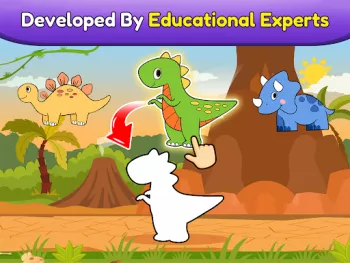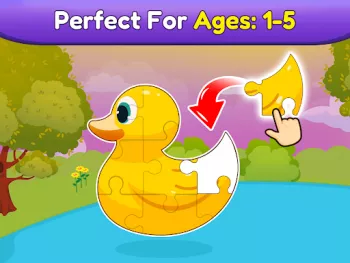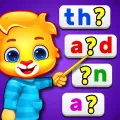Apps Home

Baby Puzzle Games for Toddlers
The Cognitive and Motor Skills Development through Puzzles
Puzzles are not just a simple form of entertainment; they are a powerful tool to enhance cognitive and motor skills among toddlers, whose growing brains eagerly soak up information from their surroundings. At the ages of 2 to 5, children enter a critical phase of cognitive development, where the ability for problem-solving and understanding cause-and-effect relationships is fostered actively. Puzzles serve as a practical methodology to advance these skills. By handling different puzzle pieces, toddlers engage their fine motor skills, which include the coordination of small muscles, such as those in the hands and fingers, with their vision. This coordination is fundamental for performing everyday tasks like writing, eating, and dressing. Furthermore, puzzles are exceptional for advancing spatial awareness as children learn to visualize how pieces fit together to form a complete image. This enhances their ability to visualize and manipulate objects mentally, a skill set that can translate into numerous educational domains, such as mathematics and science. Cognitive skills are also challenged and improved as children learn to identify various shapes and patterns, which is crucial as they begin to recognize letters and numbers. Such activities stimulate both sides of the brain, enhancing problem-solving capabilities while encouraging a level of lateral thinking. As toddlers work through puzzles, they encounter minor failures—pieces that don't fit, colors that don't match—which teach them perseverance and the value of working through problems to find solutions. This logical reasoning is critical in school and beyond. In addition, puzzles can introduce children to basic concepts like the alphabet, numbers, and category differentiation through engaging visuals and thematic designs, offering a playful yet effective educational approach through discovery and direct interaction.
The Role of Safety and Convenience in App Design for Kids
In the modern digital era, designing applications tailored for toddlers requires a meticulous focus on safety and user-friendliness, as young users are particularly curious but lack the cognitive capability to protect themselves from potential digital pitfalls. A digital environment such as Baby Puzzle Games for Toddlers ensures that their innate curiosity leads to safe explorations. One crucial aspect of safety in toddler-oriented apps is the implementation of a parental gate for sensitive areas within the application. This gate, protected by codes or similar secure mechanisms, prevents unintended setting alterations or accidental purchases that toddlers might unknowingly execute amidst their interactions. The emphasis on a secure digital play space extends to eliminating external advertisements, ensuring that the child's engagement is continuous and without unwanted interruptions, which can often lead to frustration or accidental clicks leading out of the application. These users require a frictionless interface where navigation is straightforward, thus allowing the parents to have peace of mind. Providing a platform that can be accessed offline additionally adds a layer of convenience, freeing parents from the constant requirement of internet connectivity and enabling travel-friendly educational engagement. Puzzles not only entertain but can subtly introduce topics of internet safety to children at an age-appropriate level, preparing them for increasingly complex digital interactions. In essence, the convergence of safety, accessibility, and convenience in app design reflects a dedicated effort to protect and enhance the early learning experiences of toddlers while offering a digital space that echoes the warmth and security of a trusted playroom.
Creating an Engaging and Educational Experience for Toddlers
The magic of puzzles for toddlers lies in the intricate balance between engagement and education, where the allure of fun serves as an entry point to a wealth of learning opportunities. When developing an app like Baby Puzzle Games for Toddlers, the goal is to recreate a traditional playroom ambiance within a digital space that is as interactive as it is educational. Educational experts collaborate in the design process to ensure that the puzzles are appropriate for various developmental stages, offering challenges that are neither too mundane nor overly complex but rather just right to stimulate young minds. Play being an especially powerful pedagogical tool means that each puzzle category—ranging from dinosaurs and food to more nuanced themes like sea life and plants—is carefully chosen to pique curiosity while conveying fundamental knowledge about the world. Language development is nurtured by allowing children to recognize and name objects they assemble, often through auditory feedback when pieces are correctly placed. This reinforces their vocabulary while sharpening their ability to associate words with objects—a complex cognitive process crucial in early childhood learning. Encompassing over a hundred easily identifiable objects across multiple categories ensures no monotony, as the continuously stimulating content keeps toddlers engaged longer, thus maximizing learning potential. By integrating timely hints within the puzzles, the system gently guides children without overtaking the learning process, allowing them to maintain a sense of autonomy in their problem-solving efforts. This attention to design not only leads to improved memory retention and critical thinking but also enhances emotional development as young learners experience pride in their achievements.
Technical Considerations in Designing a Toddler-Friendly App
The technical considerations involved in developing an app for toddlers, such as Baby Puzzle Games for Toddlers, are vast and necessitate a thoughtful approach to both software functionality and user interface design to ensure the application performs seamlessly. At the forefront of these considerations are the systems used to maintain the app's stability and performance across different devices, given the wide range of hardware circulating in the global market. Developers prioritize lightweight design for ease of download and operation, optimizing for both performance and battery efficiency to ensure that these playful sessions with puzzles do not unduly drain device resources. Moreover, toddler-friendly features like large touch targets and voice prompts transform potential frustration points into satisfying interactions. From a back end perspective, secure coding practices guard not only against potential mishaps but also shield user data from breaches, aligning with the stringent privacy expectations for children's applications. Such designs often involve sandboxing elements of the app, ensuring that even if one section were compromised, no significant risk could propound throughout the system. Developers may integrate a stringent testing phase, employing simulations of real-world usage scenarios to predict and correct unnoticed bugs before a public release. Additionally, accessibility features are embedded where possible to cater to diverse developmental needs, ensuring inclusivity and broad appeal. This ensures a consistent user experience regardless of a child's unique learning curve or physical capabilities, thereby offering a universally engaging educational tool. Through technical elegance and a commitment to excellence in user experience, a well-crafted toddler app becomes a staple fun-and-learn resource accessible to a young, global audience.
Download and Supporting Platforms for Baby Puzzle Games for Toddlers
The provision of a universally accessible educational app like Baby Puzzle Games for Toddlers necessitates strategic platform deployment, ensuring maximum reach and usability. The app finds its primary distribution through popular app stores, targeting platforms where the majority of users experience digital content. Given the prevalence of Android across a spectrum of devices globally, [Download for Android](https://play.google.com/store/apps/details?id=com.pzl1.toddler.puzzles) offers extensive accessibility, allowing millions of users to easily integrate the app into their array of educational resources. Although it's currently unavailable on iOS, Windows, Linux, and macOS, expansions into these areas are typically explored post-initial release to maximize audience exposure and address diverse platform preferences among parents and educators. Including a detailed description within platform marketplaces further informs potential users, outlining the app's intentions, benefits, and protective measures in place, thereby setting user expectation from the start. Constructive engagement with platform ecosystems also allows for leveraging algorithms to effectively reach target demographics, while user feedback collected through these channels provides invaluable insights for future updates and improvements. Supporting documentation, FAQs, and customer support channels are paramount to address common inquiries swiftly, reflecting the developer's commitment to user satisfaction and app excellence. As user communities grow around an app, these elements transform into a vibrant support network, exchanging ideas and furthering the app's educational reach, truly manifesting the vision of a global playroom of fun and learning.
Share Your Opinion
Your Email Will Not Be Published.
All Rights Reserved © Apps Home 2025


















































Yousef Imran
Very well made. What I like about it is how well thought the development is it. For example, if the toddler makes a mistake it or not getting it, t...
Bradley Morton
Great fun game that my 2 1/2 year old daughters absolutely loves playing. Some tasks are challenging for her but not impossibly thanks to the many ...
Theresa Digby
Exceptionally good interactive experience. Allowing toddlers to learn hand dexterity and coordination. The game allows toddlers to engage with cert...
Kawain Lane
My two children really enjoy playing this game. My 5 year old and 1 year old play together. They each take turns trying to get the shapes into the ...
Faith Willits
My son just turned 2 this month. He's been playing this game since 18mo. It's easy enough for a toddler to figure out but hard enough to challenge ...